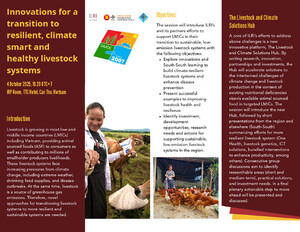
Marginal abatement cost curves of climate-smart agricultural practices to mitigate greenhouse gas emissions from smallholder dairy farms in Kenya
Abstract
Milk consumption in Kenya is projected to rise. To meet projected demand in a sustainable manner, Kenya must focus on upscaling climate-smart agricultural (CSA) practices to increase productivity. The Kenya Climate-Smart Agriculture Project has been supporting smallholder farmers to adopt integrated climate-smart Technology, Innovation and Management Practices (TIMPs). The aims of this study were to investigate the effects of these TIMPs on milk production and GHG emission intensity (EI; farm gate GHG emissions per unit of product). Survey data were collected from four counties in Kenya: Baringo, Bomet, Kericho and Laikipia. Emissions estimates were calculated for 566 farms using Agrecalc and data were analysed using multiple linear regressions accounting for variability in geographical context and production system (no graze, semi-intensive, and extensive). Mean daily milk yields ranged from 0.5 to 15.7 l/cow/day. EIs ranged from 0.6 to 12.0 kg CO2e/kg fat and protein corrected milk (FPCM), highlighting the opportunity for efficiency gains. The lowest EIs were found in Laikipia (2.4 kg CO2e/kg FPCM) and the highest in Bomet (3.1 kg CO2e/kg FPCM). This could be due to the difference in milk yields between counties and the prevalence of more extensive systems in Bomet. Dairy production system was the most important explanatory variable for the
variability in milk production and EI (P<0.001). County also had a significant effect on milk production (P<0.001) and EI (P=0.017). Increasing adoption of TIMPs led to increased milk production (P=0.068) and reduced EI (P=0.117). The largest gains in milk yield and reductions in EI were seen in extensive systems. While this was not significant, there was a strong visual trend in extensive systems, but not in intensive or semi-intensive systems. Our results show that adoption of TIMPs generally increased milk yields and decreased GHG EIs. Therefore, adoption of CSA practices could allow Kenya to increase milk production to meet projected demand, whilst keeping associated GHG emission increases below business as-usual predictions.
Citation
McNicol, L., Caulfield, M., Graham, M., Gibbons, J., Williams, A.P., Chadwick, D., Gakige, J., Wilkes, A., Kimoro, B. and Arndt, C. 2023. Marginal abatement cost curves of climate-smart agricultural practices to mitigate greenhouse gas emissions from smallholder dairy farms in Kenya. Poster. Nairobi, Kenya: ILRI.










